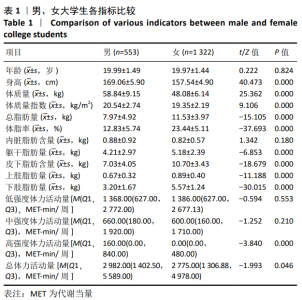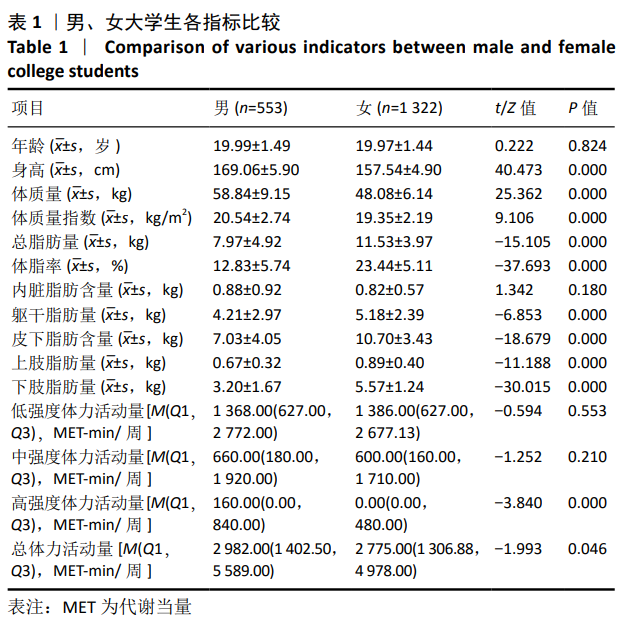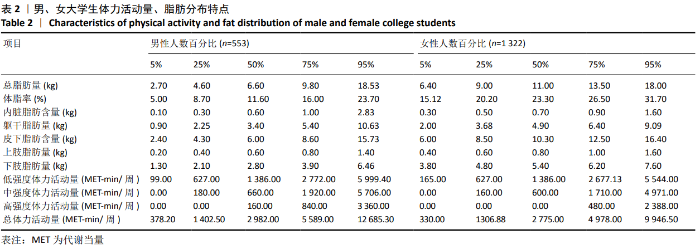[1] CASPERSEN CJ, POWELL KE, CHRISTENSON GM. Physical activity, exercise, and physical fitness: definitions and distinctions for health-related research. Public Health Rep.1985;100(2):126-131.
[2] NCD Risk Factor Collaboration (NCD-RisC). Trends in adult body-mass index in 200 countries from 1975 to 2014: a pooled analysis of 1698 population-based measurement studies with 19·2 million participants.Lancet. 2016;387(10026):1377-1396.
[3] 中国学生体质与健康研究组.2014年中国学生体质与健康研究报告[M].北京:高等教育出版社,2018:710.
[4] PHILIPSEN A, JØRGENSEN ME, VISTISEN D, et al. Associations between ultrasound measures of abdominal fat distribution and indices of glucose metabolism in a population at high risk of type 2 diabetes: the ADDITION-PRO study. PLoS One.2015;10(4):e0123062.
[5] ROSENQUIST KJ, PEDLEY A, MASSARO JM, et al. Visceral and subcutaneous fat quality and cardiometabolic risk. JACC Cardiovasc Imaging. 2013;6(7):762‐771.
[6] REBUFFÉ-SCRIVE M, ANDERSSON B, OLBE L, et al. Metabolism of adipose tissue in intraabdominal depots of nonobese men and women. Metabolism.1989;38(5):453‐458.
[7] No authors listed. Clinical Guidelines on the Identification, Evaluation, and Treatment of Overweight and Obesity in Adults-The Evidence Report. National Institutes of HealthObes Res. 1998;6 Suppl 2:51S-209S.
[8] 崔凯.不同体脂率大学生的身体成分和脂肪分布特征[D].杭州:杭州师范大学,2012.
[9] 李俊萍,张新霞,马兴友,等.北方汉族大学生皮褶厚度与体成分分析[J].解剖学杂志,2017,40(01):82-85+103.
[10] 杨羿帆,陈玉凤.体育专业学生身体脂肪与运动能力的相关性研究[J].当代体育科技, 2017,7(4):87-89.
[11] VANCAMPFORT D, VAN DAMME T, FIRTH J, et al. Correlates of physical activity among 142,118 adolescents aged 12-15 years from 48 low- and middle-income countries. Prev Med. 2019;127:105819.
[12] 张青华.澳门大学生与高中学生体力活动状况的比较研究[J].成都体育学院学报,2018,44(4):98-102.
[13] 丁鹏.四川省大学生体力活动和生命质量的现状分析与相关性研究[D].成都:四川师范大学,2018.
[14] SPIEGELMAN BM, FLIER JS. Obesity and the regulation of energy balance. Cell 2001; 104(4): 531–543.
[15] JAKICIC JM, DAVIS KK. Obesity and physical activity. Psychiatr Clin North Am. 2011;34(4):829‐840.
[16] MERLOTTI C, CERIANI V, MORABITO A, et al. Subcutaneous fat loss is greater than visceral fat loss with diet and exercise, weight-loss promoting drugs and bariatric surgery: a critical review and meta-analysis. Int J Obes (Lond). 2017;41(5):672‐682.
[17] WEWEGE M, VAN DEN BERG R, WARD RE,et al. The effects of high-intensity interval training vs. moderate-intensity continuous training on body composition in overweight and obese adults: a systematic review and meta-analysis. Obes Rev. 2017;18(6):635‐646.
[18] IPAQ Group.International physical activity questionnaire[EB/OL][2018-01-26].http: //www. ipaq. ki.se/downloads.html.
[19] 罗文超.大连地区成人身体成分的调查研究[D].大连:大连医科大学, 2013.
[20] PRICE KL,EARTHMAN CP.Update on body composition tools in clinical settings: computed tomography, ultrasound, and bioimpedance applications for assessment and monitoring.Eur J Clin Nutr. 2019;73(2): 187-193.
[21] CENICCOLA GD, CASTRO MG, PIOVACARI SMF, et al. Current technologies in body composition assessment: advantages and disadvantages. Nutrition.2019;62:25-31.
[22] 及春兰.学龄前儿童人体成分分析[J].中国妇幼保健,2015,30(29): 4989-4991.
[23] WANG ZH, YANG ZP, WANG XJ, et al. Comparative Analysis of the Multi-Frequency Bio-impedance and Dual-energy X-ray Absorptiometry on Body Composition in Obese Subjects.Biomed Environ Sci. 2018; 31(1):72-75.
[24] TINSLEY GM, MORALES E, FORSSE JS, et al. Impact of Acute Dietary Manipulations on DXA and BIA Body Composition Estimates. Med Sci Sports Exerc.2017;49(4):823-832.
[25] 付鹏宇,龚丽景,胡扬.运动对棕色脂肪功能的影响及作用机制[J].体育科学,2018,38(11):92-97.
[26] 梁成军.抗阻力量训练的减肥效果[J].湖北体育科技,2014.7(7): 603-606
[27] QUINN LS,STRAIT BL,ANDERSON BG,et al.Interleukin-15 stimulates adiponectin secretion by 3T3-L1 adipocytes: evidence for a skeletal muscle-to-fat signaling pathway. Cell Biol Int.2005;29(6):449-457.
[28] VIANA RB, DE LIRA CAB, NAVES JPA, et al. Can We Draw General Conclusions from Interval Training Studies?. Sports Med.2018;48(9): 2001‐2009.
[29] 杨乐,张宝,管石侠,等.不同性别不同年龄成年人体成分测量指标的检测分析[J].安徽医学,2019,40(11):1276-1279.
[30] BLAAK E.Gender differences in fat metabolism. Curr Opin Clin Nutr Metab Care.2001;4(6):499‐502.
[31] 周新丽,赵家军.肥胖与性激素[J].中国实用内科杂志,2011,31(4): 257-259.
[32] TOWNE SD JR, ORY MG, SMITH ML, et al. Accessing physical activity among young adults attending a university: the role of sex, race/ethnicity, technology use, and sleep. BMC Public Health. 2017;17(1): 721.
[33] SEO YJ, HA Y. Gender Differences in Predictors of Physical Activity among Korean College Students Based on the Health Promotion Model. Asian Pac Isl Nurs J. 2019;4(1):1‐10.
[34] CHOI JY, CHANG AK, CHOI EJ.Sex differences in social cognitive factors and physical activity in Korean college students. J Phys Ther Sci. 2015; 27(6):1659‐1664.
[35] 姚崇,赵闪光,毛志宏,等.体力活动干预对大学生抑郁症的改善效果与代谢机制[J].陕西师范大学学报(自然科学版),2019,47(3): 21-30+125.
[36] 汪海伟,李占宇,张晓丹.天津市部分大学生体力活动水平与身体成分的相关性[J].中国学校卫生,2018,39(8):1195-1198.
[37] 王欢,江崇民,蔡睿,等.不同职业人群的体力活动水平——基于加速度计和活动日志数据[J].体育科学,2016,36(5):33-38.
[38] MILLS C, GILES G. Body Image concerns of Male Rugby Players,with specific focus on Muscularity and Body Fat.Muscularity and Body Fat. Journal of Obesity and Overweight.2017; 3(1): 1-8.
[39] ALLEVA JM, VELDHUIS J, MARTIJN C. A pilot study investigating whether focusing on body functionality can protect women from the potential negative effects of viewing thin-ideal media images. Body Image.2016;17:10‐13.
[40] ALLEVA JM, MARTIJN C, VAN BREUKELEN GJ,et al. Expand Your Horizon: A programme that improves body image and reduces self-objectification by training women to focus on body functionality. Body Image. 2015;15:81‐89.
[41] IBRAHIM MM. Subcutaneous and visceral adipose tissue: structural and functional differences. Obes Rev. 2010;11(1):11‐18.
[42] ZHANG H, TONG TK, QIU W, et al. Comparable Effects of High-Intensity Interval Training and Prolonged Continuous Exercise Training on Abdominal Visceral Fat Reduction in Obese Young Women. J Diabetes Res. 2017;2017:5071740.
[43] TREMBLAY A,DESPRÉS JP,LEBLANC C,et al.Effect of intensity of physical activity on body fatness and fat distribution.Am J Clin Nutr.1990;51: 153-157.
[44] JENSEN MD. Lipolysis: contribution from regional fat. Annu Rev Nutr. 1997;17:127‐139.
[45] WAHRENBERG H, LÖNNQVIST F, ARNER P. Mechanisms underlying regional differences in lipolysis in human adipose tissue. J Clin Invest. 1989 ;84(2):458-467.
[46] OHKAWARA K, TANAKA S, MIYACHI M, et al. A dose-response relation between aerobic exercise and visceral fat reduction: systematic review of clinical trials.Int J Obes (Lond). 2007;31(12):1786-1797.
[47] Wajchenberg BL. Subcutaneous and visceral adipose tissue: their relation to the metabolic syndrome. Endocr Rev. 2000;21(6):697‐738.
[48] 宇克莉,郑连斌,李咏兰,等.海南临高人身体成分分析[J].人类学学报,2017,36(1):101-109.
[49] BJÖRNTORP P. Do stress reactions cause abdominal obesity and comorbidities?. Obes Rev. 2001;2(2):73‐86.
[50] 葛晓川,黄亚茹,毛小云,等.4周运动结合饮食控制对肥胖青少年体脂分布与血脂代谢的影响[J].中国运动医学杂志,2015,34(10): 994-997.
|









